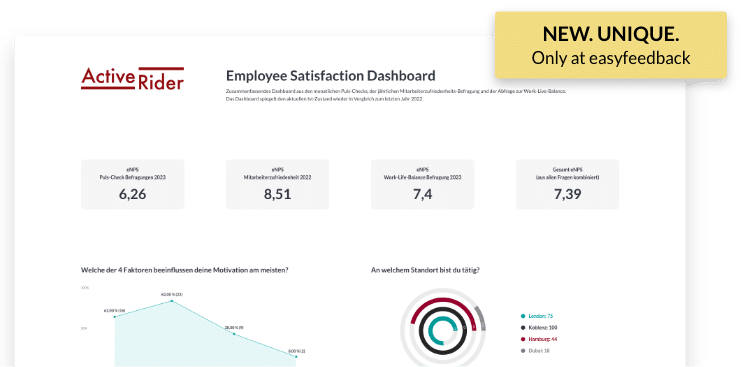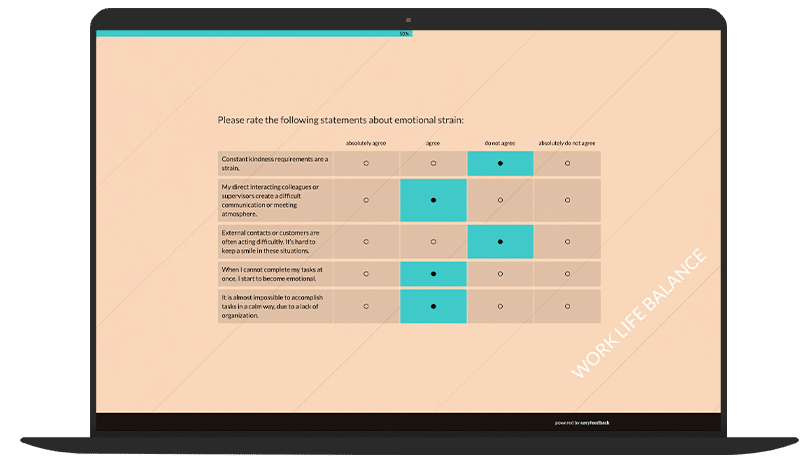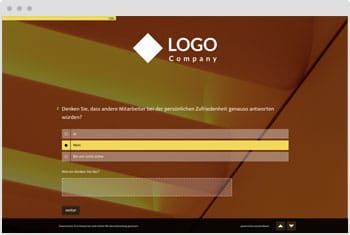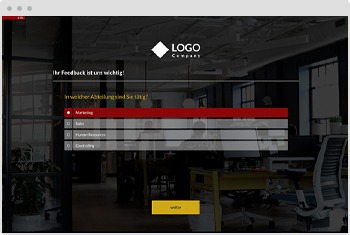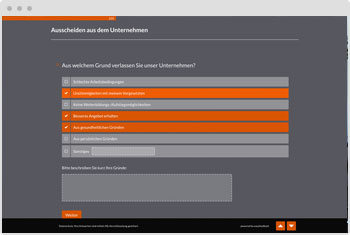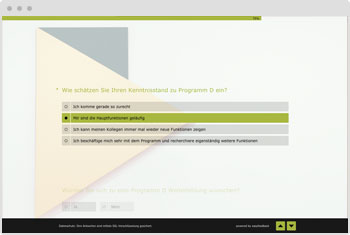Identify and reduce stress at work through targeted employee feedback

With this ready-to-use survey template, you can determine the workplace stress of your employees in order to initiate countermeasures at an early stage. This increases employee satisfaction in the long term.

“Identifying customer needs is an essential part of our business. easyfeedback accompanies us for many years as a loyal partner in this task. We particularly appreciate the intuitive usability of the survey tool as well as the professional support.”
Guild Lead User Experience Research

“We use easyfeedback for internal and external surveys – fast, comfortable and really easy! Straightforward and cordial support can always create a smile. We really appreciate the permanent development of the platform.”
Guest & Competitor Insights Analyst
Content and targets of this workplace load template
Personal workplace load is rarely visible from the outside. The effects only become visible after a delay. When performance drops due to stress, it is often too late.
Detect emerging stresses in time with a targeted employee survey. Gain insight into the true situation of daily workplace stress and satisfaction in the various areas.
With an anonymous survey, you can also find out the reasons. Detect undesirable developments at an early stage and avoid problems such as those caused by discrimination. Create the possibility to react and not let workplace stresses increase too much.
Content:
• Mental stress
• Physical stress
• Emotional load
• Monotony, one-sided stress
• Excessive demands, high performance requirements
• Social stress
• Discrimination
• Measuring job satisfaction
Targets:
• Determine physical workplace stress
• Determine the psychological workplace stress
• Identify personal changes
• Reduce stress levels
• Increase of job satisfaction

Data privacy protection „made in Germany“ (GDPR)

Anonymity functions for open feedback
Almost everything you need to know about workplace load
1. What is mental stress in the workplace?
In general, mental stress is understood to be all external influences that come up at work and have a psychological effect on people.
Influences such as a temporarily higher workload, occasional overtime or a bad-tempered boss can occur from time to time in an employee’s daily work routine. This usually has no direct consequences.
However, if the psychological stress at work persists over a longer period of time, such as in the case of a permanently high work intensity due to staff shortages, the stress can have negative consequences.
One possible consequence can be an employee’s internal resignation. This means that the employee has already made an inward commitment to the company, which can affect his or her willingness to perform and also the mood within the team. Further negative consequences can be the actual termination or the absence of the employee due to illness.
According to a study by the german company Wellnow, 85% of employees feel stressed by their work. For 77% of those surveyed, the stress has a physical effect, and for 38%, a psychological one. From a business perspective, it therefore makes sense to counteract increased psychological stress in the workplace in order to counteract possible employee absenteeism and a decline in the company’s effectiveness.
2. What factors cause psychological stress at work?
The main cause of mental stress in the workplace is stress. This can be triggered by various factors.
One of these factors could be a permanently high workload, which can only be compensated by permanent overtime. But constantly increasing time pressure can also place a heavy burden on employees. Poor working conditions, such as high noise levels, poor lighting or temperatures that are too high or too low, also have a negative impact.
Another important aspect is the personal interaction within the team. Does a harsh tone prevail at the workplace, strong competitive behavior or is there bullying by colleagues or managers? If so, these are factors that can place a heavy burden on the employee in the long term.
We have listed all the factors mentioned above and many other possible stressors in the workplace below:
- high work intensity
- increasing time pressure
- frequent overtime
- monotony
- lack of material or personal resources
- aggressive behavior in the workplace
- competition between employees
- mobbing/bossing
- poor communication,
- lack of agreements
- job insecurity
- poor working conditions (noise, lighting, temperature, etc.)
- overwork (burnout)/underwork (boreout)
- imbalance between required performance and received appreciation
3. Why should you measure the workload of your employees?
According to a german medical journal , the number of mental illnesses (largely depression, burnout, anxiety disorders and addictions) has risen sharply in the last 20 years. The number of sick days due to mental illness also increased. Compared to other illnesses, the absenteeism of affected employees is three times higher.
Prevention is therefore an important starting point. But where do you get the information you need about the areas in which workplace stress is particularly high? And where can you start?
Everyone deals differently with the many small and large challenges of everyday work. One employee is motivated to familiarize himself with a new area, while another is overwhelmed. Personal workplace stress is therefore rarely immediately apparent from the outside. The effects only become apparent after some time.
A regular employee survey is therefore particularly suitable for localizing psychological stress at the workplace. Based on the results, you can identify undesirable developments at an early stage and avoid problems such as those that can arise from mobbing.
It also gives you the opportunity to react and keep workplace stresses to a minimum. On the one hand, this helps you to avoid sickness-related absences of your employees and, on the other hand, it gives you the opportunity to positively influence the effectiveness of your company. This benefits your employees and your company as well.
One more hint: A change of working conditions is rarely a high cost factor, but only requires initiative and a rethinking within the company. So start here and influence the working climate for your employees sustainably.
4. What are the possible consequences of stress and other strains in the workplace?
The consequences of stress in the workplace are manifold. For example, if the workload is so high that the employee can no longer cope with the tasks, the employee may become demotivated and resigned. As a result, his willingness to work and productivity can suffer. In the worst case, the employee may become ill over time.
In general, a distinction can be made between mental and physical illnesses. Mental illnesses include burnout syndrome or depression. Physical ailments can be cardiovascular diseases, tinnitus, migraine or back problems.
These illnesses can lead to anything from a short-term absence due to illness to a complete absence of the employee. The number of sick days is usually higher for an employee who suffers from psychological stress at work than for an employee who is not exposed to increased stress. For the employer, the absence of an employee is associated with high financial losses due to lost production or loss of work productivity.
5. What should the questionnaire for measuring workplace stress look like?
As a general rule, design the questionnaire for measuring workplace stress clearly and limit yourself to the most important questions. First of all, think about a concept. Which employees do you want to survey? For example, in which areas is the workload or sick leave proportionally higher than in others?
It is important to measure mental, physical and emotional stress and to ask about possible excessive demands and discrimination. For example, have your employees rate their job satisfaction on a scale. The next step could then be to ask about the reasons for the rating. Questions about the relationship with colleagues and the supervisor also provide important insights.
Tip: Very few employees like to openly admit that they are overloaded with their work. The fear of being classified as “not efficient” is too great. Conduct the survey anonymously. This will give you an honest insight into the day-to-day work of your employees.
Creating an employee survey is very easy. With easyfeedback, you can quickly and easily create your own questionnaire on the topic of workplace stress or use our ready-made survey template.
6. What findings can I derive from the questionnaire on workplace stress?
A job satisfaction and stress questionnaire is a valuable tool that provides you with honest employee feedback. You gain insight into the daily physical and psychological workplace stress of your employees and their satisfaction in the various areas.
Based on the results, you first determine the current state. You recognize in which areas there are problems and what kind they are. In the second step, you can then target the problems and make concrete recommendations for action.
In this way, you improve your employees’ working conditions and strengthen their loyalty to the company by making it more attractive. In this way, you also fulfill your duty of care as an employer and avoid the sickness-related absence of your employees due to workplace stress.
You are in professional company







easyfeedback welcomes more than 740.000 participants per month!
